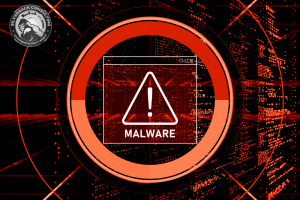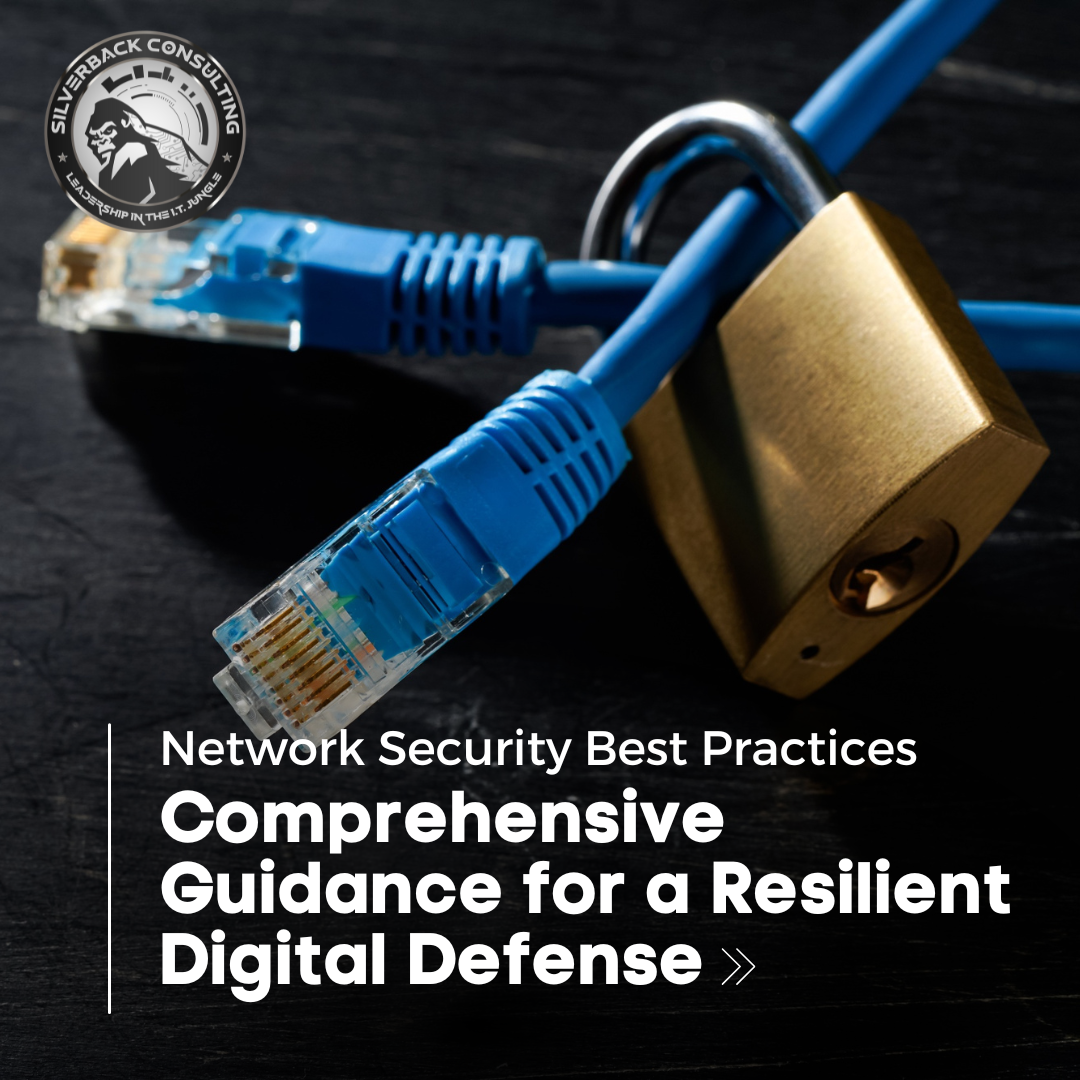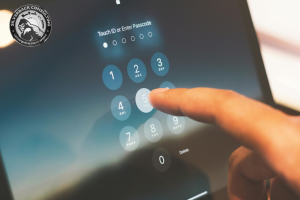Introduction
Every cyber threat that slips through a weak network can cost your business more than just data—it can cost trust, compliance, and reputation. Network security best practices are the blueprint for preventing those risks.
They define how your organization protects sensitive information, defends against emerging attacks, and stays ahead of hackers who are always evolving their methods.
At Silverback Consulting, we believe security isn’t just about technology—it’s about building a resilient framework that adapts as threats evolve.
Here’s how to turn best practices into daily operations that keep your network and your business secure.
Your Network Security FAQs: Straight Answers from the Pros
2 Network Security Threat Prevention: Building a Strong Perimeter
Segment and Secure Your Network
One of the fundamental network security best practices is network segmentation.
Splitting the network into zones using VLANs or routers contains breaches and allows different security controls in each zone.
Creating a demilitarized zone (DMZ) to host externally facing services isolates the internal network if a web server is compromised.
Extreme segmentation, such as air‑gapped systems for backups or sensitive servers, ensures that critical data remains disconnected from potentially compromised networks.
Proper placement of firewalls and other security devices is vital. Modern firewalls with intrusion‑prevention and DDoS mitigation capabilities should be positioned at every junction between network zones.
Web application firewalls belong in the DMZ, while load balancers and DNS servers should sit behind them to control traffic flow and prevent attacks like SQL injection or cross‑site scripting.
Physical and Device‑Level Security
Physical access to network equipment is often overlooked.
We at Silverback Consulting recommend strictly controlling entry to wiring closets, server rooms and data centers, and prohibiting USB drives to prevent data exfiltration.
Personal firewalls installed on each computer provide an additional barrier, blocking unauthorized inbound or outbound traffic.
When feasible, implement application whitelisting so that only approved software can run; this reduces malware execution but requires regular updates to remain effective.
Using a web proxy server to manage internet access allows you to authenticate and monitor outbound connections. This prevents malware inside the network from communicating with command‑and‑control servers.
Combining physical controls with network security best practices ensures both digital and physical resilience.
Principle of Least Privilege and Strong Authentication
Limiting user permissions is critical to stopping insider threats. Enforcing the principle of least privilege reduces the impact of credential compromise, and combining it with strong authentication measures ensures stolen credentials cannot be reused.
We recommend role‑based access control (RBAC), regular audits to prevent privilege creep and strict policies for multi‑factor authentication (MFA).
Encouraging password manager use and enforcing account lockout policies after repeated failed attempts also strengthens defenses.
Use Secure Remote Access and Zero Trust Models
Virtual private networks (VPNs) remain indispensable for remote connectivity, providing encrypted tunnels over public networks.
However, the SANS Institute explains that modern attacks often target outdated VPN clients and remote desktop services. That’s why Zero Trust Network Access (ZTNA) frameworks are gaining traction.
ZTNA operates on the principle of “never trust, always verify”; every request is authenticated and authorized, regardless of location.
SANS highlights key steps when adopting ZTNA: replace legacy VPN infrastructure with lightweight agents, integrate ZTNA with endpoint security, use strong firewall and email security solutions, enforce MFA, leverage network segmentation and deploy advanced threat detection tools like XDR or NDR.
By connecting users only to specific applications and devices instead of entire networks and verifying device health before granting access, ZTNA significantly reduces lateral movement.
ZTNA strengthens network security by eliminating implicit trust and continuously validating every connection.
Vendor Diversification for Resilience
Relying on a single vendor for all security solutions introduces a single point of failure. Using multiple vendors enhances resilience; if one vendor’s product is compromised, other solutions continue to protect the environment.
This strategy also fosters competition, leading to innovation and cost efficiency.
3 Network Security Detection and Response: Staying Alert to Threats

Baseline Your Network and Monitor Traffic
Establishing a baseline of normal protocol usage allows you to detect anomalies.
Gathering data from routers, switches, firewalls, wireless access points and other sources to create this baseline. Then, monitoring for deviations that could signal data tunneling or malware activity.
Analyze typical traffic patterns and use machine learning and behavioral analytics to spot anomalies.
Regular reviews help identify trends, spikes or irregularities warranting investigation.
Employ Honeypots and Intrusion Detection Systems
Honeypots and honeynets act as decoy assets to lure attackers and allow security teams to study tactics. They divert malicious actors away from real systems and provide intelligence for better threat management.
Intrusion Detection Systems (IDS) and Intrusion Prevention Systems (IPS) are crucial; they monitor network traffic for suspicious patterns and generate alerts.
IDS detects and alerts administrators about anomalies, while IPS can automatically block or mitigate threats.
By comparing current activity against baselines and recognizing attack signatures, IDS/IPS can spot ransomware or SQL injection attempts even when the activity doesn’t violate baseline protocols.
Automate Response Where Appropriate
Automation accelerates reactions to known threats.
Modern tools can block malicious IP addresses, terminate suspicious connections and collect information about the intrusion to aid investigations.
Automating routine responses frees teams to focus on complex events and ensures swift containment.
Centralize Logs and Use SIEM
Aggregating logs from various devices into a Security Information and Event Management (SIEM) system enables thorough correlation and analysis.
We recommend centralizing log collection to support comprehensive detection and compliance reporting. SIEM tools can detect patterns and anomalies, assist in forensic investigations and provide valuable context for incident response.
Centralized visibility is a cornerstone of good network security practices, enabling proactive threat management.
Plan and Practice Incident Response
Preparation matters. We can’t stress enough about the importance of a detailed incident response plan with defined roles, escalation protocols and playbooks for different scenarios.
Regular tabletop exercises and live simulations help teams identify weaknesses and refine response strategies.
Post‑incident reviews feed lessons learned back into policies, ensuring continuous improvement.
4 Protect Your Data: Confidentiality, Integrity and Availability
Encrypt Data in Transit and at Rest
Encryption protects sensitive information from unauthorized access.
Use strong encryption standards (such as AES‑256) to secure data at rest and enforcing SSL/TLS protocols for data in transit.
Regularly review encryption policies to align with evolving standards and compliance requirements.
Regular Backups and Data Classification
Frequent backups ensure business continuity in the event of ransomware or hardware failure.
We recommend scheduling routine snapshots, storing copies in multiple locations (including offline or air‑gapped systems) and testing restoration procedures.
Not all data is equally sensitive. Creating a data classification framework (public, internal, confidential, highly confidential) allows you to apply appropriate controls. Highly sensitive data should be encrypted, access‑controlled and continuously monitored.
Data loss prevention tools help enforce policies and prevent unauthorized sharing.
Limiting storage access and enforcing MFA on storage systems further reduces risk.
5 Secure Systems and Software
Automate Patch Management and Hardening
Unpatched vulnerabilities are a primary target for attackers.
Implement automated patch management to deploy updates across operating systems, applications and security tools.
Scheduling regular updates minimizes downtime and eliminates human error.
Hardening operating systems by disabling unnecessary services, restricting administrative privileges and applying security baselines reduces the attack surface.
Application whitelisting, strong password policies and properly configured firewalls complement this hardening.
Vulnerability Scanning and Penetration Testing
Continuous vulnerability scanning identifies weaknesses before adversaries do.
We suggest using automated scanners across applications, networks and connected devices and supplementing them with annual penetration tests.
Prioritize remediation based on severity and document results for continuous improvement.
Endpoint Protection
Endpoints are often entry points for attackers. Deploying endpoint detection and response (EDR) solutions and next‑generation antivirus (NGAV) tools provides real‑time visibility and leverages machine learning to detect sophisticated attacks.
Enforce policies restricting unauthorized software installations and require data encryption on all devices.
6 Develop Robust Network Security Policies and Train Your People
 Document Security Policies and Procedures
Document Security Policies and Procedures
Policies serve as the blueprint for consistent network security management across your organization.
We emphasize creating comprehensive documentation covering access control, data protection, incident response and change management.
Clear documentation supports day‑to‑day operations, audits and investigations.
Educate and Empower Employees
Human error is a leading cause of breaches. We recommend regular training on phishing awareness, social engineering tactics and safe online behavior.
Tailor programs to job roles and supplement them with simulated phishing campaigns to reinforce learning.
Emergency Protocols and Change Management
Define emergency protocols specifying roles, escalation paths and playbooks for various attacks. Conduct simulations to refine these protocols.
Additionally, formalize change management to control network configurations and maintain audit trails.
Automated change management tools help detect unauthorized changes and ensure accountability.
7 Conclusion: Continuous Improvement and Expert Partnership
Defending against today’s cyber threats requires continuous attention to network security best practices.
Combining network security best practices–from segmentation, access control and encryption to proactive monitoring, incident response and employee training, creates a layered defense that adapts to evolving risks.
Implementing multiple vendors and automating responses can further enhance resilience.
Regular backups, password managers, documentation and training are critical components of good network security practices.
At Silverback Consulting, we are dedicated cybersecurity experts committed to helping organizations implement these practices effectively.
We encourage you to assess your current posture, adopt a Zero Trust mindset and continuously refine your strategy.
By following good network security practices, you can protect sensitive data, maintain uptime, and stay compliant.
8 Why is cybersecurity important?
Cybersecurity protects your business from data breaches, downtime, and financial loss. Without it, even a small vulnerability can lead to major damage and compliance issues.
9 Our web servers sit on the same network as our internal systems. How risky is that, and who can help design a proper DMZ?
It’s very risky. A shared network can expose internal systems to public-facing threats. A cybersecurity firm like Silverback Consulting can design a secure DMZ (demilitarized zone) to isolate web servers safely.
10 Is there an affordable service that can audit our current LAN and recommend segmentation strategies for better security?
Yes. Silverback Consulting offers cost-effective LAN security assessments and segmentation audits tailored to your network size and complexity.
11 We recently moved offices and are worried about unauthorized access to our server room. What physical controls should we consider?
Use electronic keycard systems, surveillance cameras, motion sensors, and secure racks. Combine these with strict access policies and regular security checks.
12 How do we prevent employees from plugging unknown USB sticks into our network? Can we enforce that through policy or technology?
Yes. Establish a device control policy and use endpoint protection tools that block unapproved USB devices. Silverback can help configure these controls.
13 We lack in-house expertise on safeguarding network hardware. Are there consultants who can review our setup and make recommendations?
Absolutely. Silverback Consulting specializes in hardware security audits and can identify vulnerabilities across routers, switches, and firewalls.
14 Our staff are tired of password resets. What’s the best way to introduce multi-factor authentication that they’ll actually use?
Adopt modern MFA solutions like push notifications or biometrics. They’re secure and user-friendly, reducing password fatigue while improving protection.
15 Could a cybersecurity partner manage our user access controls and help maintain least-privilege principles?
Yes. Silverback Consulting provides access control management that enforces least-privilege and tracks permissions to prevent privilege creep.
16 With more employees working from home, is a traditional VPN enough, or should we migrate to Zero Trust Network Access?
Traditional VPNs are no longer enough. Zero Trust Network Access (ZTNA) verifies every connection—ideal for hybrid work environments.
17 Are there experts who can integrate endpoint security with a Zero Trust solution for a mid-sized business like ours?
Yes, Silverback Consulting can help your business deploy endpoint security within a Zero Trust framework to close every security gap.
18 We rely on a single vendor for our firewall, antivirus, and SIEM. Does that make us vulnerable? How do we diversify safely?
It can. Relying on one vendor increases systemic risk. Silverback can evaluate your stack and suggest complementary security tools for resilience.
19 Can an external consultant help us evaluate and implement complementary security tools to reduce single-vendor risk?
Yes. External consultants like Silverback offer multi-vendor strategy planning to strengthen your defenses and ensure interoperability.
20 How do we establish a ‘normal’ baseline for our network traffic so we can detect anomalies?
Start by monitoring regular network patterns over time. Advanced monitoring tools or managed security services can create this baseline for you.
21 Are there tools or services that can continuously monitor our network and alert us to suspicious patterns?
Yes, SIEM platforms and managed detection services continuously scan for anomalies and send real-time alerts.
22 We don’t have a dedicated SOC. Can a managed service provider handle network monitoring and anomaly detection for us?
Yes. Managed Security Service Providers (MSSPs) like Silverback Consulting can provide 24/7 monitoring without the cost of an in-house SOC.
23 Do honeypots really help stop hackers, or are they more trouble than they’re worth?
Honeypots don’t stop attacks but help detect intrusions early. When managed properly, they offer valuable threat intelligence.
24 Should we invest in intrusion detection, intrusion prevention, or both?
Ideally both. IDS alerts you to suspicious activity, while IPS can automatically block threats in real time.
25 Is there a cybersecurity firm that can deploy and manage honeypots and IDS/IPS for a small IT team?
Yes, Silverback Consulting provides fully managed intrusion detection and prevention systems, plus honeypot deployment for smaller teams.
Ready to Fortify Your Network? Let’s Secure Your Future
Your business deserves more than basic protection—it needs a network defense strategy built for today’s threats. Our cybersecurity experts can assess your vulnerabilities, implement advanced safeguards, and keep your operations secure 24/7.
📞 Call us today at (719) 452-2205 or fill out the contact form below to schedule your free network security consultation.
Let’s make sure your business stays one step ahead of cyber threats.
Silverback Consulting
303 South Santa Fe Ave
Pueblo, CO 81003
719-452-2205
support@silverbackconsulting.us
“Leadership in the I.T. Jungle”




 Before discussing the best practices, it is useful to recall the core network devices that support or enforce security. These technologies form the backbone of good network security practices that safeguard your organization’s digital assets.
Before discussing the best practices, it is useful to recall the core network devices that support or enforce security. These technologies form the backbone of good network security practices that safeguard your organization’s digital assets.

